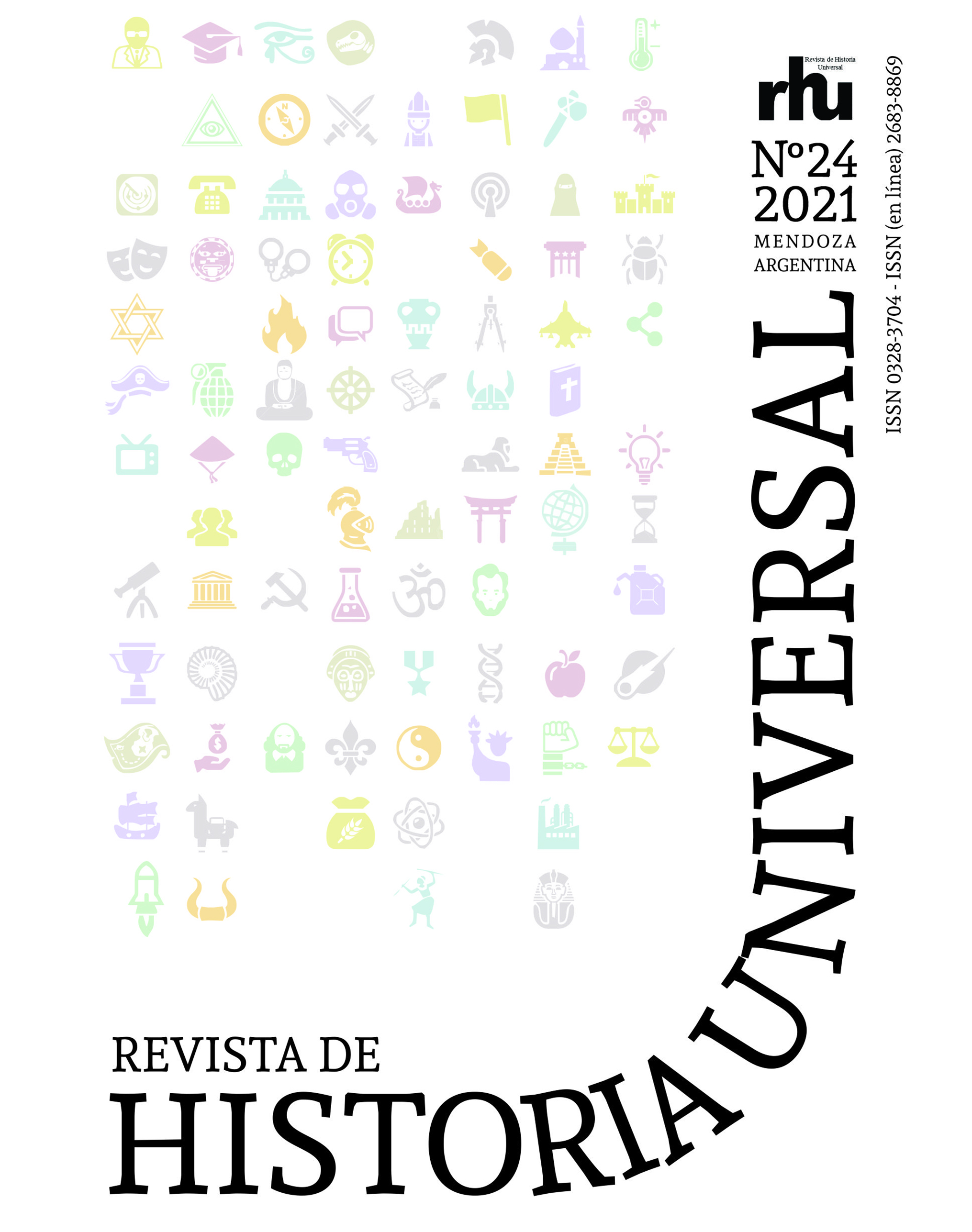Antiguos constructores de otredad. Poblaciones seminómadas en el imaginario estatal egipcio
Palabras clave:
Seminómadas, Estado, Otredad, IdeologíaResumen
El presente trabajo se propone analizar los aspectos positivos y negativos derivados de las relaciones existentes entre el Estado y las poblaciones seminómadas que tienen lugar en determinados momentos y contextos históricos de la historia del antiguo Egipto. A partir de la revisión de las fuentes bibliográficas estatales -que incluye tanto fuentes iconográficas como literarias- se detecta que la presencia de los habitantes de las zonas periféricas de Egipto fue una constante. Sin embargo, desde esta perspectiva oficial de corte ideológica el otro es percibido de modo reduccionista: como un agente del caos o amenaza. Desde una perspectiva más abarcadora y comprehensiva de la interrelación de mundos distintos, el presente estudio intenta identificar los factores que favorecieron la efectiva integración de los extranjeros u otros en la sociedad egipcia.
Citas
Assmann, J. (2008), Religión y Memoria Cultural. Buenos Aires: Libros de la Araucaria.
Baines, J. (1996), Contextualizing Egyptian Representations of Society and Ethnicity. En J.S. Cooper & G. M. Schwartz (Eds), The Study of the Ancient Near East in the Twenty-First Century (pp. 339-384). Winona Lake: Eisenbrauns,.
Baines, J. (2005), Definiciones tempranas del mundo egipcio y sus alrededores, RIHAO 12, 111-148.
Bard, K. (1992), Toward an Interpretation of the Role of Ideology in the Evolution of Complex Society in Egypt, Journal of Anthropological Archaeology 11, 1-24.
Bar-Yosef, O. & Khazanov, A. (1992), Pastoralism in the Levant. Archaeological Materials in Anthropological Perspectives. Madison: Prehistory Press.
Barth, F. (1976), Los grupos étnicos y sus fronteras. México: F.C.E.
Berger, P. y Luckmann, T. (2006), La construcción social de la realidad. Buenos Aires: Ed. Amorrortu.
Bourdieu, P. (2009), La eficacia simbólica. Religión y política. Buenos Aires: Ed. Biblos.
Cardoso de Oliveira, R. (2007), Etnicidad y estructura social, México: Centro de Investigaciones y Estudios Superiores en Antropología Social, UNAM.
Castañeda Reyes, J.C. (2003), Sociedad Antigua y respuesta popular: movimientos sociales en Egipto Antiguo. México, Universidad Autónoma Metropolitana: Plaza y Valdés Editores.
Cohn, N. (1995), El cosmos, el caos y el mundo venidero. Barcelona: Ed. Crítica.
Cornelius, S. (2010), Ancient Egypt and the Other, Scriptura, 104, 322-340.
Daneri, A. (1992), Las dinastías VII-VIII y el período heracleopolitano en Egipto. Problemas de reconstrucción histórica de una época de crisis. Colección Estudios 6. Buenos Aires: Anexos de Revista de Estudios de Egiptología (REE).
De Aguiar e Silva, V.M. (1982), Teoría de la literatura. Madrid: Ed.Gredos.
Emberling, G. & Yoffee, N. (1999), Thinking about ethnicity in Mesopotamian Archaeology and History, en Nissen, H./Kühne, H., Fluchtpunkt Uruk: Archäologische Einheit aus methodischer Vielfat, Leidorf: RahdenWestf.
Endrödi, J. (1991), Figurative Discourse and Communication in the emerging state of Egypt. Göttinger Miszellen 125, 18-27.
Espinel, D. (2003), Antes del combate. La información sobre el enemigo y su execración durante el Reino Antiguo. Supplementa ad Isimu. Estudios Interdisciplinares sobre Oriente Antiguo y Egipto. Serie II, Vol.II. Madrid: Ed. UAM, 317-328.
Espinel, D. (2006), Etnicidad y Territorio en el Egipto del Reino Antiguo. UAB. Barcelona: Ed. Bellaterra.
Faulkner, R. (1962), A Concise Dictionary of Middle Egyptian. Oxford: Oxford University Press.
Finkelstein, I. (1995), Living on the Fringe: The Archaeology and History of the Negev, Sinai and Neighbouring Regions in Bronze and Iron Ages. Monographs in Mediterranean Archaeology 6. London: Sheffield.
Flammini, R. (2007), Lecturas egipcias de la alteridad asiática. Cahiers Caribéens d’Egyptologie, 10, 99-115.
Galán, J.M. (1998), Cuatro viajes en la Literatura del Antiguo Egipto. Madrid: Consejo Superior de Investigaciones Científicas.
Kamp, K.A. & Yoffee, N. (1980). Ethnicity in Ancient Western Asia during the Early Second Millennium B.C.: Archaeological Assessment and Ethnoarchaeological Prospectives. Bulletin of the American Schools of Oriental Research (BASOR), 237, 85-104.
Kemp, B.J. (1984), Nomads and the Outside World. Cambridge: Cambridge University Press.
Kemp, B.J. (1992), El Antiguo Egipto. Anatomía de una civilización. Barcelona: Crítica.
Khazanov, A. (2015), Pastoral nomadic migrations and conquests. Editada por Kedar, B.Z. & Wiesner. Cambridge: Cambridge. University Press.
Hanks, M.E. (eds.). The Cambridge World History. Vol.V. Expanding Webs of Exchange and Conflict, 500 CE-1500 CE. Cambridge: Cambridge University Press, 359-382.
Kroeber, A.L. (1948), Anthropology. New York: Harcourt.
Lichtheim, M. (1976). Ancient Egyptian Literature (Vol.1). Berkeley: University of California Press.
Luft, U. (1991), Asiatic in Illahum: A preliminary report. Actas VI Congreso Internazionale di Egittologia, Turín.
Lupo de Ferriol, S. (2004), El Estado egipcio y Nubia. Los cambios en las estrategias de control durante el Reino Antiguo, Reino Medio e Imperio. BAEDE, 14. 43-61.
Marx, E. (1992), ¿Are there Pastoral Nomads in the Middle East. En O. Bar-Yosef. & A. Khazanov, A. (Eds.), Pastoralism in the Levant. Archaeological Materials in Anthropological Perspectives. (pp. 255-260. Madison: Prehistory Press.
Loprieno, A. (1988). Topos und Mimesis. Zum Ausländer in der Ägyptischen Literatur (ÄA 48), Wiesbaden : Harrassowitz.
Oren, E. (1973), The Overland Route Between Egypt and Canaan in the Early Bronze Age, en Israel Exploration Journal –IEJ- , 23(4). 198-205.
Parra Ortiz, J.M. (2009). El Antiguo Egipto. Sociedad, Economía, Política, Madrid: Marcial Pons Ediciones de Historia.
Porter, A. (2012), Mobile Pastoralism and the formation of Near Eastern Civilizations. Weaving Together Society. Cambridge: Cambridge University Press.
Redford, D. (1995), Egypt, Canaan and Israel in Ancient Times. El Cairo: The American University in Cairo Press.
Rodríguez, R.R. (2010), Ethnicity and interethnic relations during Egypt’s Old Kingdom, en Advances in Egyptology N° 1, Armenian Egyptology Centre. Yerevan, Armenia: Yerevan State University, 43-51.
Rubio Hernández, R. (2007). Antropología, religión, mito y ritual. Madrid: Universidad Nacional de E. a D.
Sard, K. (1991), The Development of Nomadism in Ancient Northeast Africa. Philadelphia: University of Pennsylvania Press.
Saretta, P. (2016), Asiatic in Middle Kingdom Egypt. Perceptions and Reality. London: Bloomsbury Publising Plc.
Schneider,T. (2010), Foreigners in Egypt: archaeological evidence and cultural context. En W. Wendrich, (Ed.) Egyptian Archaeology (pp. 143-163). London: Wiley-Blackwell.
Shaw, I. (2007), Historia del Antiguo Egipto. Madrid: La Esfera de los Libros.
Silva Castillo, J. (2005), Nomadism Through the Ages. En D. Snell (Ed.), A companion to the ancient Near East (pp.126-140). Oxford: Blackwell.
Silva Castillo, J. (1982), Nómadas y pueblos sedentarios. México: Centro de Estudios de Asia y Africa.
Stallaert, C. (1998). Etnogénesis y etnicidad. Barcelona: Ed. Proyecto.
Van Dijk, T. (2005), Ideología y análisis del discurso, Utopía y Praxis Latinoamericana,10(9), 9-36.
Wengrow, D. (2007), La arqueología del Egipto arcaico. Transformaciones sociales en el noreste de Africa (10.000-2650 a.C.). Barcelona: Ed. Bellaterra.




















